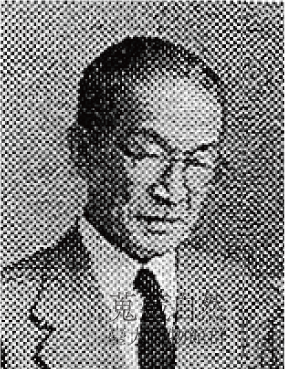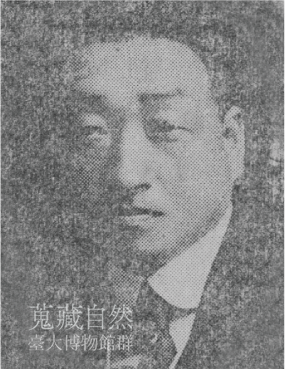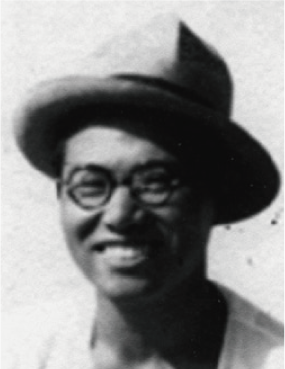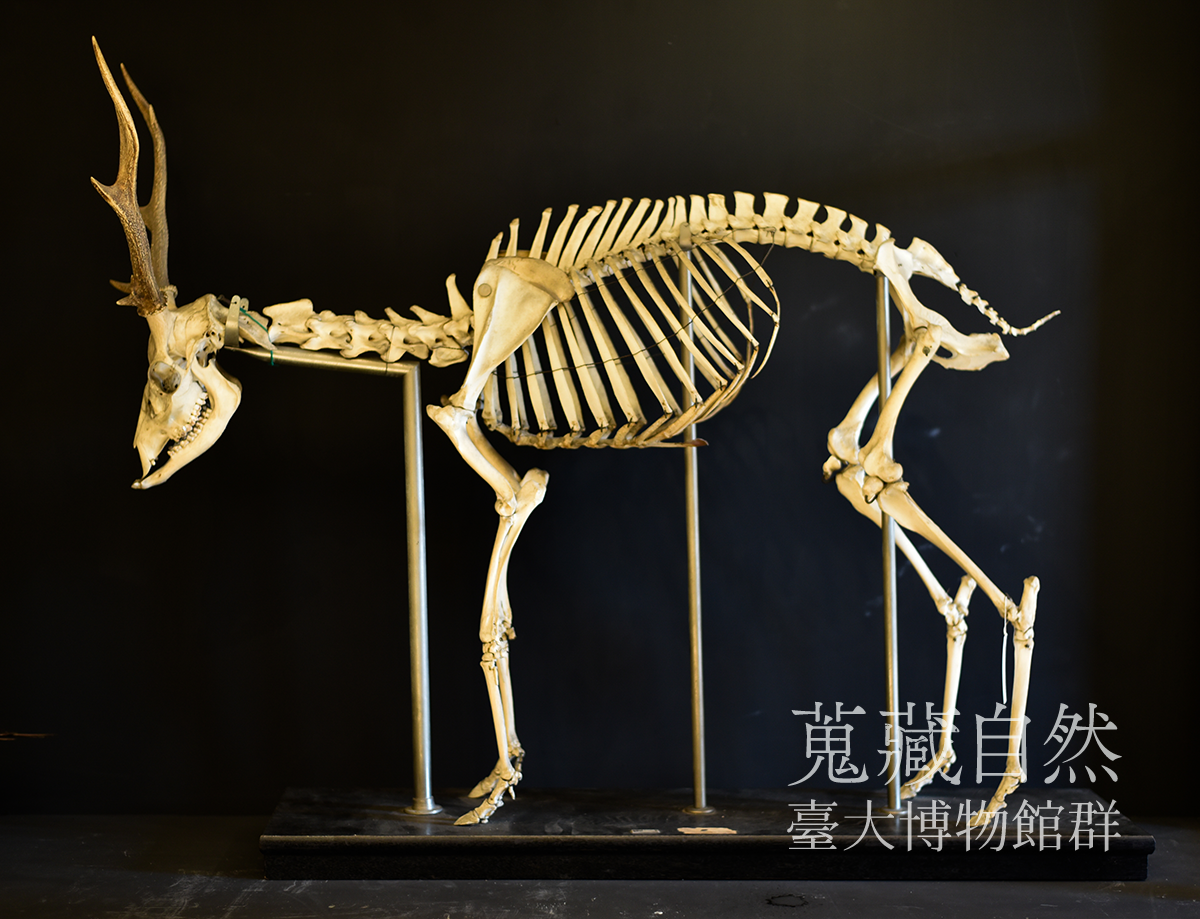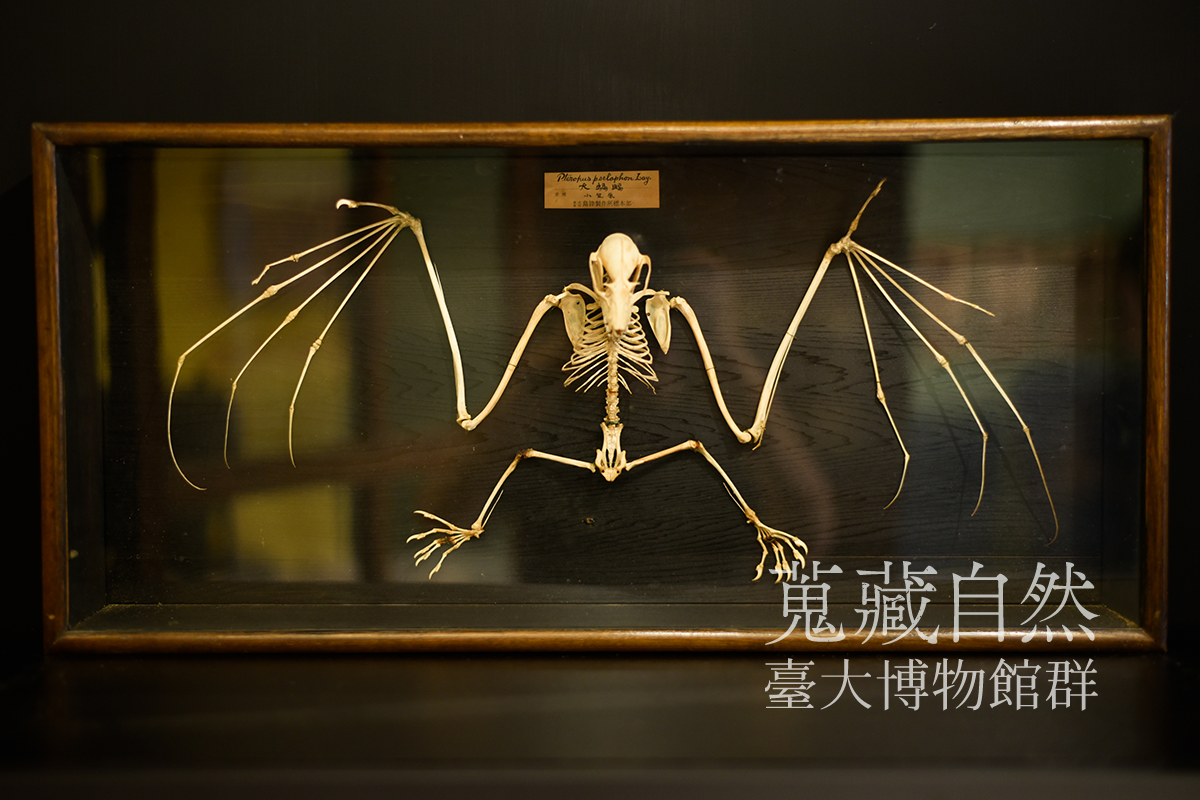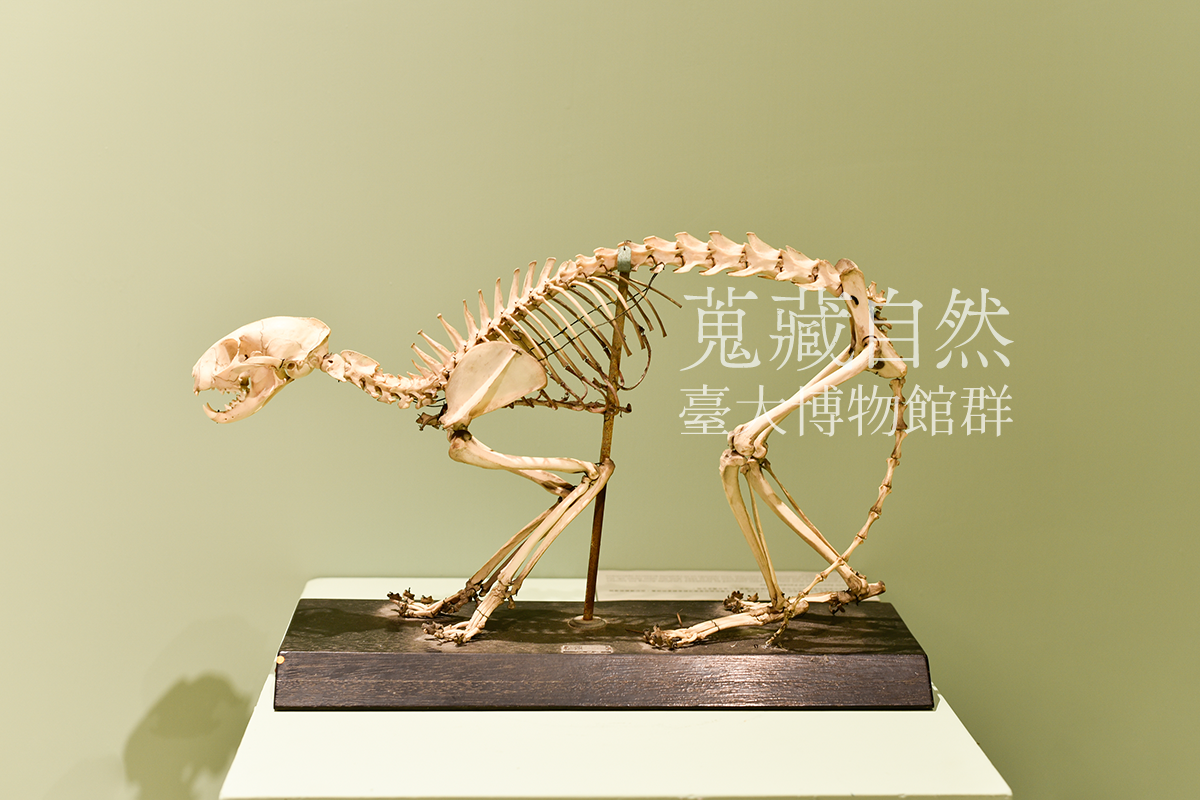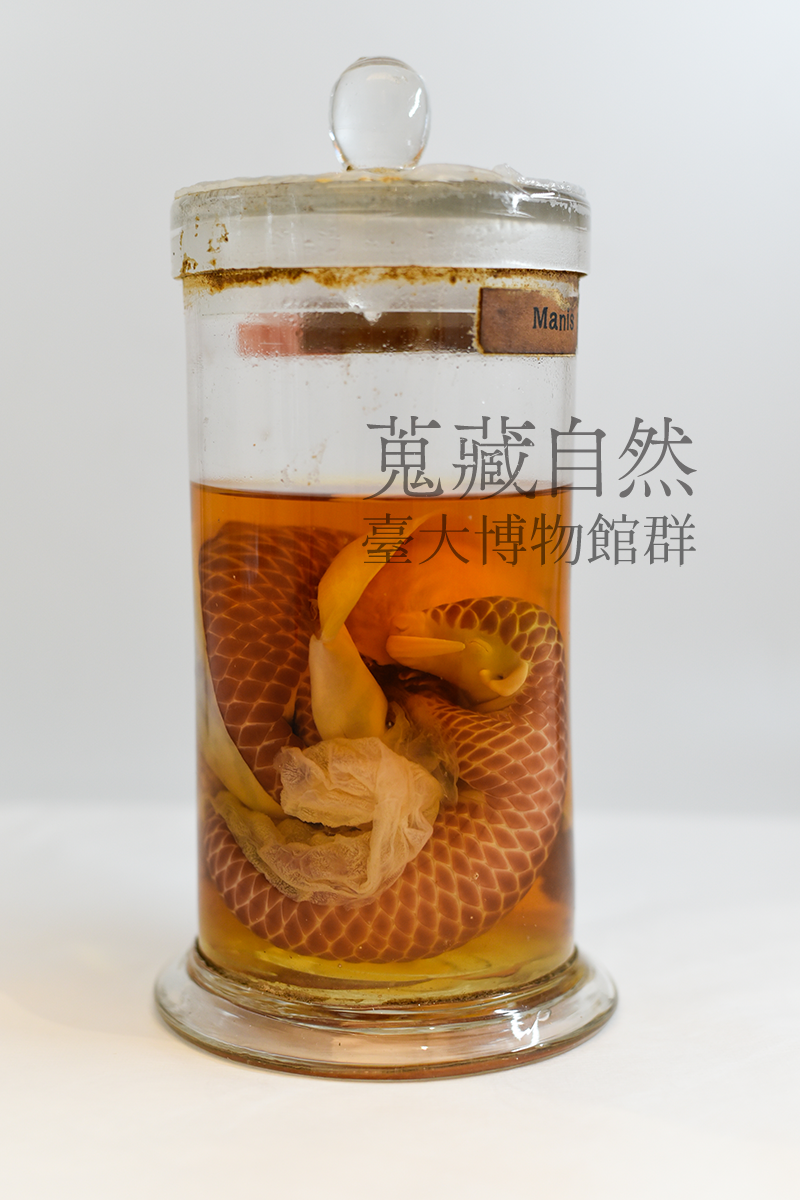動物博物館NTU Museum of Zoology
本館成立於1928年,早期的標本典藏以臺灣本土及鄰近地區的鳥類、哺乳類、貝類及珊瑚等類群為主;爾後因應經濟發展需求,專注於鼠類及魚類的收集;近年來收藏則取決於研究人員的研究方向,例如蚯蚓、仔稚魚以及蝙蝠和鼩鼱等小型哺乳動物,目前總館藏超過兩萬件。
直到1999年前,大型動物的骨骼標本,擺放在一號館入口兩旁古色古香的展櫃;而懸吊在走廊天花板的小鬚鯨及領航鯨骨骼標本,更是許多老臺大人的記憶。隨著動物學系由一號館搬遷至生命科學館,這些標本也跟著搬到生命科學館一樓展示廳,以「生命科學新體驗」特展重新面世。這些標本統合在「聲音」的主題下,顯現動物多樣的生態特性,也希望這個特展能帶給參觀者不同以往的生命科學新體驗。
The Museum was established in 1928. The early collections focused on the native fauna of birds, mammals, shellfish, and corals in Taiwan and neighboring areas. Later, in response to the need for economic development, the Museum focused on rodents and fish. In recent years, the collections have been primarily contingent on the faculty member’s research interests. Currently, the collection comprises over 20,000 specimens.
Until 1999, skeletal specimens of large animals were on display in antique wooden cabinets at the entrance of Building No. 1. Skeletons of a small baleen whale and a pilot whale were hung from the ceiling of the hallway. The sight of those skeletal specimens has become a collective memory of many alumni. In 1999, these specimens were moved with the Department of Zoology from Building No. 1 to the Life Science Building. After relocation, the specimens were again on display in the form of the “A New Experience of Life Science” special exhibition in the exhibition hall on the 1st floor of the Life Science Building. Taking an integrative approach, this exhibition is organized under the theme of “sound,” aiming to show the diverse ecological characteristics of animals. Visitors can experience novel approaches to life science through this exhibition.
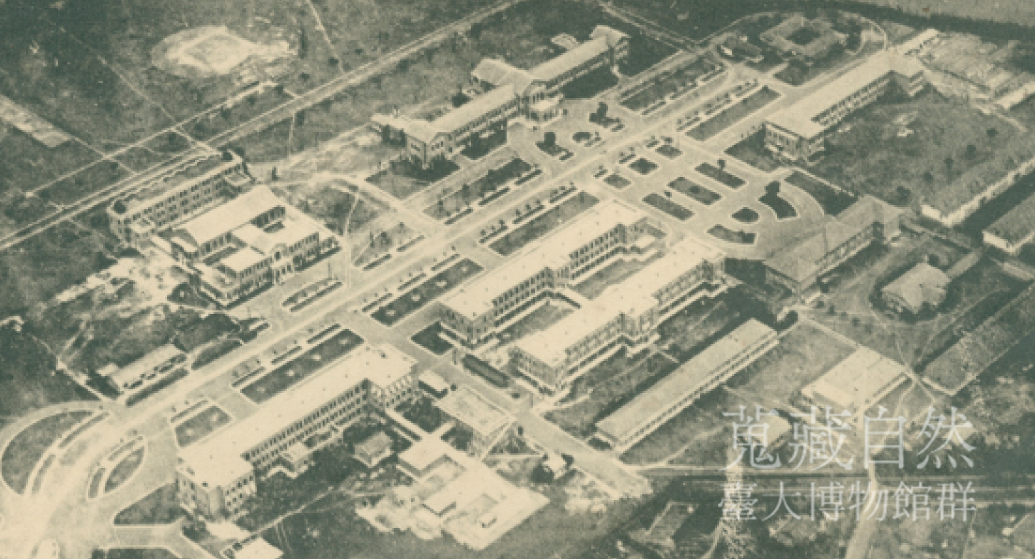
臺北帝國大學昭和六年空拍圖 (提供:臺大圖書館特藏組)
Ariel View of Taihoku Imperial University in Showa 6 (1931)
臺北帝國大學於1928年成立於臺北高等農林學校原址,隨後即開始擴建校區。新建館舍分別由理農學部、文政學部、附屬圖書館等使用。本空圖拍照於1931年,可以清楚看到當時校園的全貌。
Taihoku Imperial University was established in 1928 on the original site of Taihoku Senior School of Agriculture and Forestry. The campus expanded by the construction of new buildings soon afterward. These new buildings hosted the Faculty of Science and Agriculture, the Faculty of Literature and Politics, and the Library. The aerial photograph shot in 1931 shows the entire campus back at the time.
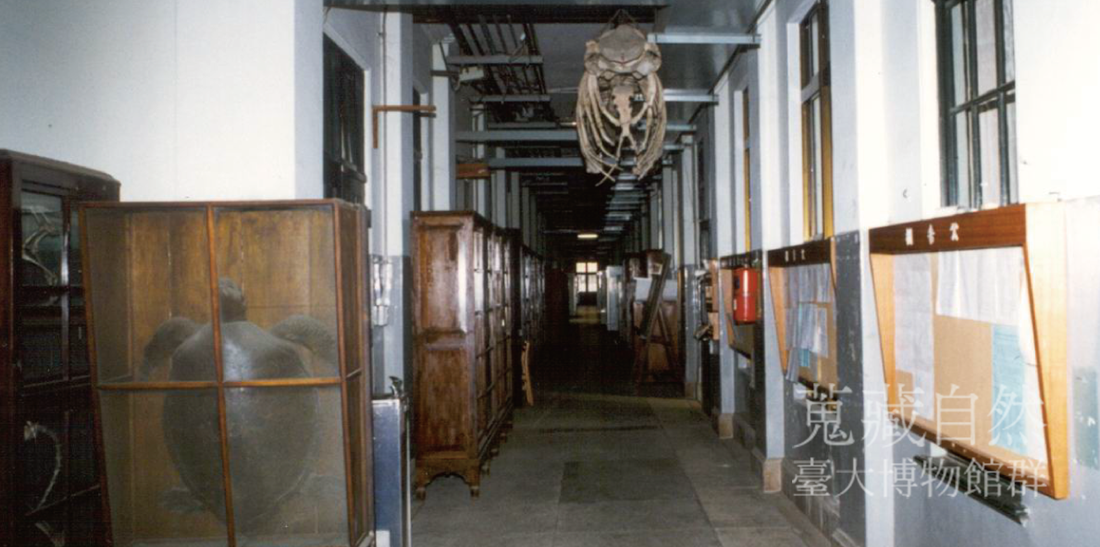
懸吊鯨豚的走廊
Cetacean Skeletons Hanged from the Ceiling of the Hallway
動物博物館原稱動物標本館,位於一號館及後方建築物內,照片中可以清楚看到大門到走廊之間的標本櫃,而在天花板懸吊的鯨魚標本,讓一號館的空間充滿不一樣的氛圍,也是長久以來校友的珍貴集體記憶之一。
The Zoological Museum (now the NTU Museum of Zoology) was originally located in Building No. 1 and the associated buildings behind. This photo shows the specimen cabinets exhibited in the hallway of Building No. 1. The skeletal specimen of a whale hanged from the ceiling stood out as a part of collective memories among the alumni.
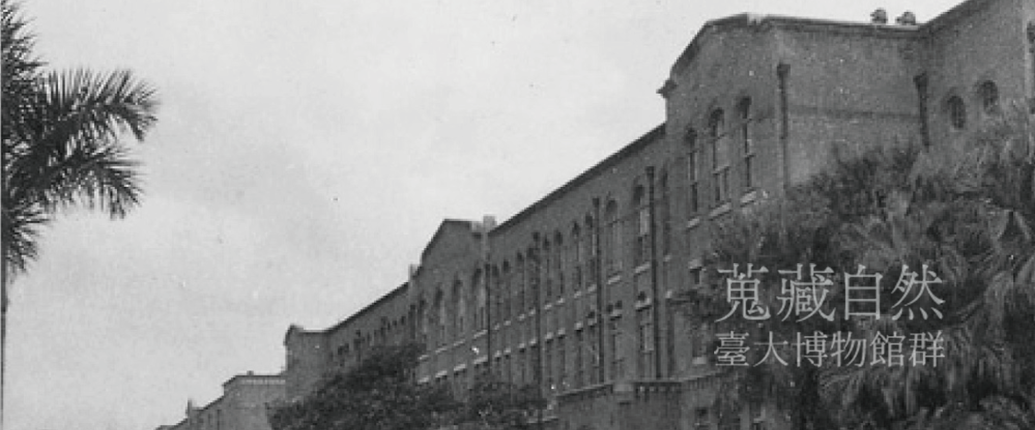
一號館 (原臺北帝國大學生物學教室) 外觀照1950 (提供:康有德,校史館)
本照片為戰後1950年代一號館照片,為早期理學院動物系及植物系館舍,同時也為臺北帝大時期動物學講座之館舍。
Building No. 1 (Biology Building of Taihoku Imperial University) in 1950.
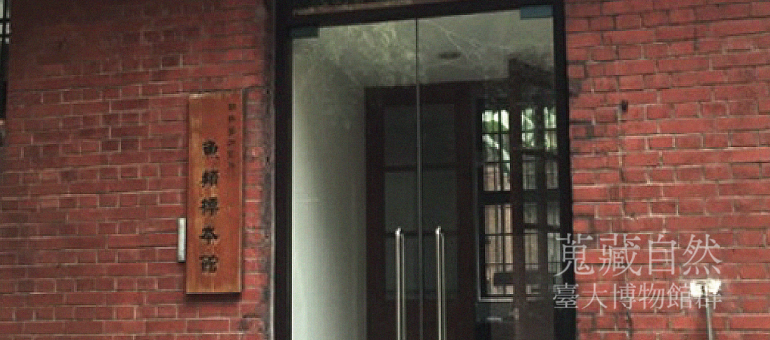
魚類標本館-動物博物館的開始
Ichthyological Specimen Cottage: The Root of the Museum of Zoology
位於一號館後方,興建於1927年的紅磚小屋是動物標本館最早所在的位置。隨著標本數量逐年累積,此建物只容納得下魚類標本典藏,因此於1970年代改名為魚類標本館
This red-brick cottage was built in 1927 and was the original site of the Zoological Museum. With the increasing size of specimen collection, it is no longer possible to hold the entire zoological collection in this cottage. By 1970s, this building held only the ichthyological collection and was renamed as the Ichthyological Specimen Cottage in the 1970s.
臺北帝國大學.自然史研究
動物相關人物小誌
People
平坂恭介
Hirasaka Kyosuke, 1887-1965
1887年生
1911年東京帝國大學動物學科畢業,任農商務省水產局、御木本真珠養殖場技師,名古屋市舊制第八高等學校教授
1928-1945年臺北帝國大學理農學部教授
1945-1948年臺灣大學教授
1949-1959年日本新潟大學教授
1965年逝世
代表研究著作:
平坂恭介。1930。軟體類:食性。岩波書店。
平坂恭介。1933。儒艮(ジュゴン)。天然紀念物調查報告。臺灣總督府內務局。
川口四郎
Kawaguti Siro, 1908-2004
1908年生於日本愛知縣
1930年東京帝國大學理學部動物學科畢業
1931年臺北帝國大學理農學部助手
1932-1942年臺北帝國大學理農學部講師
1942-1943年臺北帝國大學理農學部助教授
1943年取得臺北帝國大學博士學位
1943-1945年臺北帝國大學理學部助教授
1949-1973年岡山大學教授
1973-1978年川崎學院教授
2004年逝世
代表研究著作:
Kawaguti Siro. 1937, 1941, 1943. On the physiology of reef corals I-VII. Palao Tropical Biological Station Studies 1: 187-198, 199-208, 209-216; 2: 309-317, 319-328, 617-673, 675-679.
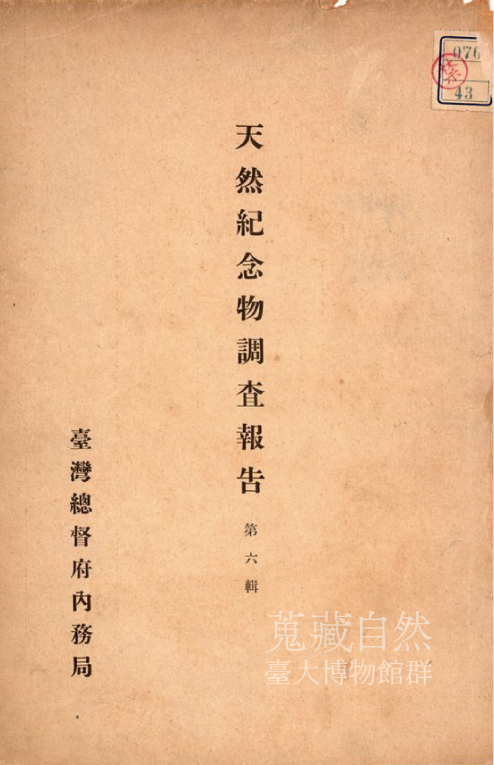
天然紀念物調查報告 第六輯
Survey Report on Natural Monuments, Volume VI
臺灣早期對野生動物的認知是基於其利用價值。有鑑於野生動物的使用遽增,臺灣總督田健治郎於大正11 年(1922),頒布「史蹟名勝天然記念物保存法在臺施行令」,昭和5 年(1930)成立「臺灣總督府史蹟名勝天然紀念物調查會」,記錄保護臺灣特有古蹟名勝及動植物資源。臺北帝國大學理農學部教授青木文一郎、助教授立石新吉等參與調查並撰寫報告書。此為由總督府內務局於昭和15 年(1940)3 月5 日出版《天然紀念物調查報告 第六輯》。
Early awareness of wild animals in Taiwan began with their value in use. In view of the rapid increase in the use of wild animals, the Governor-Genereal of Taiwan, Den Kenjiro, promulgated the “Enforcement Decree on the Preservation of Historic Sites and Natural Monuments in Taiwan” in Taisho 11 (1922). The “Historic Sites and Natural Monuments Survey Society” was established in Showa 5 (1930) to record and protect Taiwan’s unique historic sites and biological resources. The report was completed by Professor Aoki Bunichiro and Assistant Professor Tateishi Shinkichi from the Faculty of Science and Agriculture of Taihoku Imperial University. This is the “Survey Report on Natural Monuments, Volume VI” published on March 5, Showa 15 (1940), by the Department of Internal Affairs of the Governor-General of Taiwan.
相關文物
Antique
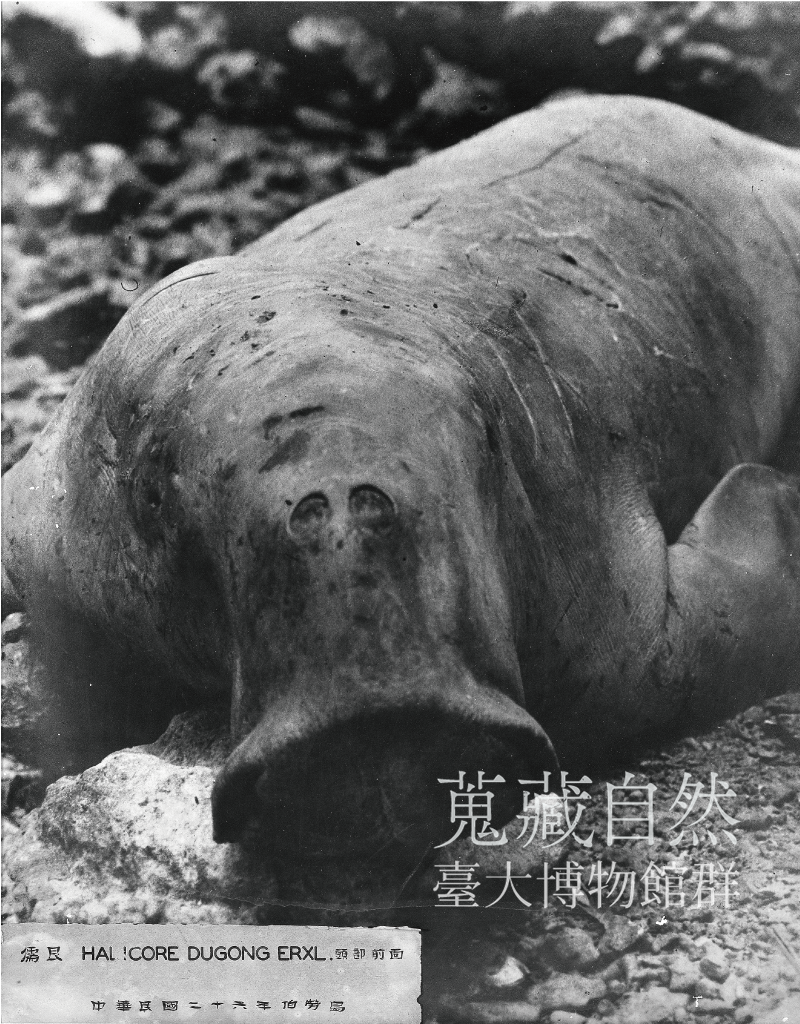
捕抓到的儒艮
Captured Dugong
此儒艮為1937年由漁民在巴士海峽區域捕獲,並由青木文一郎教授帶回臺灣進行解剖及標本製作,該儒艮的骨骼標本及皮毛標本目前由臺灣博物館典藏,解剖影片則由本校人類學博物館所保存。此張照片為當初在捕抓當地所留下的影像照片。本校另有一隻儒艮骨骼標本,為同年於帛琉捕獲,運回臺北帝大由平坂恭介教授製成標本。
This dugong was captured by the fishermen in the Bashi Channel in 1937. Professor Aoki Bunichiro brought it to Taiwan for dissection and making specimen. The skeleton and taxidermy specimens of this dugong is now in the collection of the National Taiwan Museum. The video graphic documentation of the dissection is kept by the NTU Museum of Anthropology. This photograph was taken in the location where it was captured. NTU also held the skeleton of another dugong, which was captured in Palau also and made into skeleton specimen by Professor Hirasaka Kyosuke.
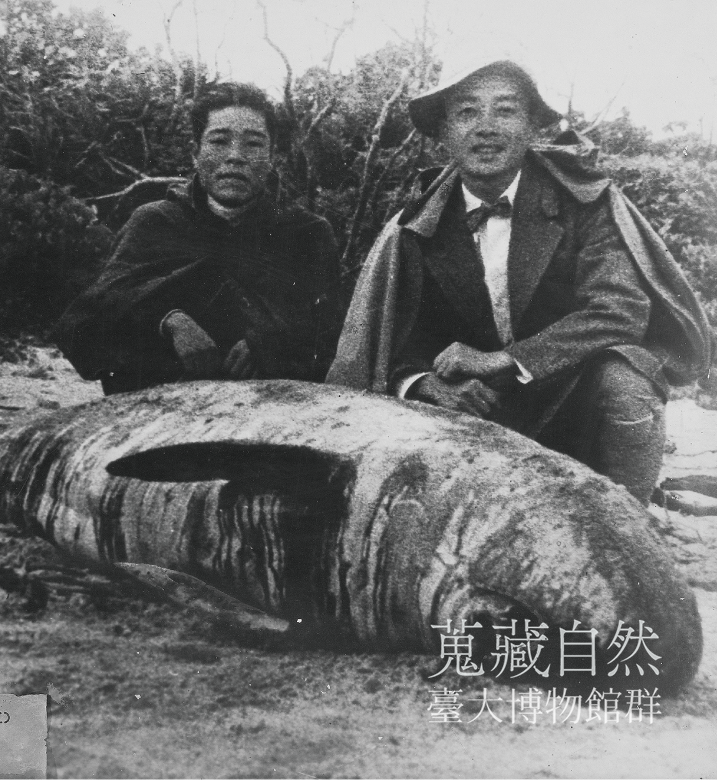
擱淺的小抹香鯨 Kogia breviceps
Beached Pygmy Sperm Whale ( Kogia breviceps Blainville)
照片為1935年擱淺於石垣島的小抹香鯨,其骨骼於翌年春天送抵臺北帝大,由平坂恭介教授鑑定。小抹香鯨是一種小型的齒鯨,由於生性隱密,因此對其生態習性了解有限。目前對小抹香鯨的認識主要來自於擱淺個體所製成的標本。
The pygmy sperm whale in the photograph was beached in Ishigaki Island in 1935. In the spring of 1936, the skeleton of this pygmy sperm whale was delivered to Professor Hirasaka Kyosuke of Taihoku Imperial University for identification. The pygmy sperm whale is a small toothed whale. Because of its secretive nature, the behavior and ecology of pygmy sperm whale remain elusive. Our current understanding of pygmy sperm whale comes primarily from specimens made from beached individuals.
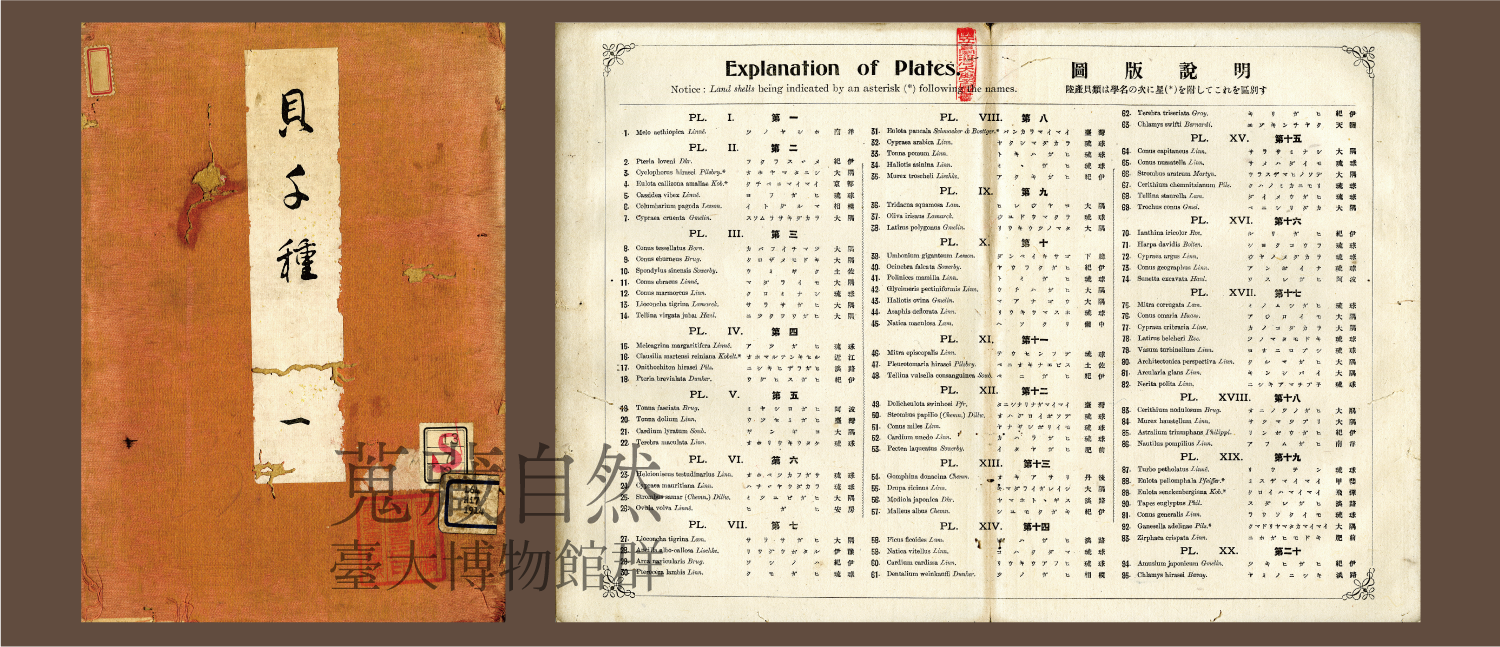
貝千種一~三繪本
Kai Senshu Illustrated Guide, Volumes I-III
平瀨介館為亞洲第一間貝類博物館。館長平瀨與一郎先生於1914年出版了貝類圖鑑《貝千種》。臺北帝大了藏有平瀨介館的標本外,也有這本早期的貝類圖鑑。但本書在動物系圖書館裡被埋沒多年,直到陳俊宏教授找到這本書之後才開啟了《貝千種》重見天日的旅程。
Kai Senshu, an illustrated guide of shellfish, was published in 1914 by Hirase Yoichiro, the curator of the first shellfish museum in Asia, Hirase Shellfish Museum. Taihoku Imperial University received the collection and Kai Senshu from Hirase Shellfish Museum after its closure. However, this book ended up being left unnoticed in the zoological library for many years. Kai Senshu was only reintroduced to the world until Professor Jiun-Hong Chen found it by chance.
川口四郎帛琉日記剪影
A Passage from Siro Kawaguti’s Palao Diaries
帛琉在大航海時代成為西班牙屬地,西班牙於1899年將帛琉與新幾內亞一併售予德國。第一次世界大戰爆發後日本派兵佔領帛琉,戰後帛琉成為日本帝國的海外領地。日本學術振興會於1936年6月於帛琉柯羅州設立熱帶生物研究所。時任臺北帝大動物學第一講座講師的川口四郎於研究所成立之後立即進駐,進行珊瑚礁研究。川口四郎於帛琉的觀察發現為後來珊瑚生理研究奠定重要基礎。此影像取自川口四郎帛琉日記,內文摘譯如下:「因為在柯羅州熱帶生物研究所周圍的珊瑚礁上行走,我帶來的地下足袋全都已經損壞無法使用。我的腳原本有足袋覆蓋所以看起來比較白,但是我開始赤腳走路之後,只剩下腳底是白的。現在我的腳看起來就像帛琉人一樣了。」
Following Spanish and German administrations in the 19th century, Palao (Palau) became an overseas dependency of the Japanese Empire after World War I. Palao is currently spelled Palau; the former was used during Japanese colonial rule. In June 1936, the Japan Society for the Promotion of Science established the Palao Tropical Biological Station in Koror. As soon as the station was in place, Siro Kawaguti, a young zoology lecturer from Taihoku Imperial University, arrived at the station to study coral reef biology. Kawaguti’s observations and findings in Palau are the pioneers of modern works in coral physiology. This image was taken from Kawaguti’s diary, which was written during his stay in Palau. It translates as: “All my Jikatabi had been torn apart by walking on coral reefs around the Palao Tropical Biological Station in Koror. There were white marks of Jikatabi on my feet, but they became well-tanned except for my white soles since I started walking on my bare feet. Now, my feet look similar to those of Palau people.” The English translation was adopted from Satoh, T., Iguchi, A., Okaji, K., Nakamura, T., 2012. Materials for the Study of Reef-Building Corals: Reports by Dr. Siro Kawaguti during His Stay in the Palao Tropical Biological Station in 1936-1940, Galaxea, Journal of Coral Reef Studies, Vol. 14 Supplement.
梅花鹿骨骼標本
Sika Deer Skeleton Specimen
本件梅花鹿骨骼標本為臺北帝大動物學教室自上野科學社(於1930年在日本上野龜住町創立)購置,標本座上貼有上野科學社的紙質出產標籤及釘有臺北帝大理農學部金屬標籤。動物骨骼標本為移除毛皮、肌肉與臟器後,保留完整骨架之標本,多用於展示及教學使用。
This particular skeleton specimen of sika deer was purchased from the Ueno Scientific Corporation (established in 1930 in Ueno Kamezumi-cho, Japan) by the Zoological Institute of Taihoku Imperial University. The specimen stand is affixed with a paper production label from the Ueno Scientific Corporation and a metal label from the Faculty of Science and Agriculture, Taihoku Imperial University. To make the skeleton specimen, the fur, skin, musculature, and internal organs are removed, and the complete skeleton is preserved. Skeleton specimens are often used for display and education.
小笠原狐蝠 (大蝙蝠) 骨骼標本
Bonin Flying Fox (Megabat) Skeleton Specimen
本件小笠原狐蝠骨骼標本為臺北帝大動物學教室購自島津製作所標本部,採集自小笠原島,標本座上貼有島津製作所標本的紙質出產標籤及標本盒上則釘有臺北帝大理農學部金屬標籤。
This skeleton specimen of Bonin flying fox (Pteropus pselaphon Lay), a megabat, was purchased from Shimadzu Corporation by the Zoological Institute of Taihoku Imperial University. This specimen was originally collected from the Ogasawara Islands. The specimen stand is affixed with a paper production label from the Shimadzu Corporation and a metal label from the Faculty of Science and Agriculture, Taihoku Imperial University.
石虎骨骼標本
Leopard Cat Skeleton Specimen
本件骨骼標本出產及採集標籤佚失,無法確認出產地,但仍釘有臺北帝大理農學部金屬標籤。石虎為臺灣原生貓科動物,但因人類開發造成棲地破碎、道路殺害、人類捕殺、農藥中毒等幾個因素,導致族群數量銳減,為國內瀕危物種。
The production and collection labels for this skeleton specimen are missing, making it impossible to identify its origin, but it still bears the metal label from the Faculty of Science and Agriculture, Taihoku Imperial University. The leopard cat is a native feline species in Taiwan. Due to as habitat fragmentation caused by human development, roadkill, human hunting, and pesticide poisoning, the native leopard car population has sharply declined in recent years, making it an endangered species in Taiwan.
穿山甲浸液標本
Pangolins Wet Specimen
本件為穿山甲胎兒的浸液標本。穿山甲於日治時期即有完整的研究,時任臺北帝國大學動物學第二講座的青木文一郎教授於1940年出版的《天然紀念物調查報告 第六輯》特別針對穿山甲進行調查及報告,提到穿山甲一年一胎,只產一頭,但因人為濫捕因素導致族群數銳減,因此特別需要公告為天然紀念物,並劃定保育區加以保育。 「浸液標本」係將生物標本透過藥劑固定防腐,再放入保存溶液裡製成。浸液標本在經過適當的處理後,能保留完整的形態特徵,特別是其他方法無法保存的軟組織。
This wet specimen features a late-stage fetus of pangolins. Research on pangolins in Taiwan can be traced back to Professor Aoki Bunichiro of Taihoku Imperial University during the Japanese rule. In his 1940 report “Survey Report on Natural Monuments, Volume 6,” Professor Aoki specifically investigated and reported on pangolins. Aoki pointed out that pangolins give birth to only one offspring each year and called for conserving pangolins as a natural monument due to a significant population decline caused by excessive hunting. As a result, conservation areas were designated to protect them. A wet specimen is a biological specimen preserved and fixed in a solution. If processed properly, wet specimens can preserve a specimen’s complete set of morphological characteristics, especially that of the soft tissues, which are otherwise not preserved by other methods.
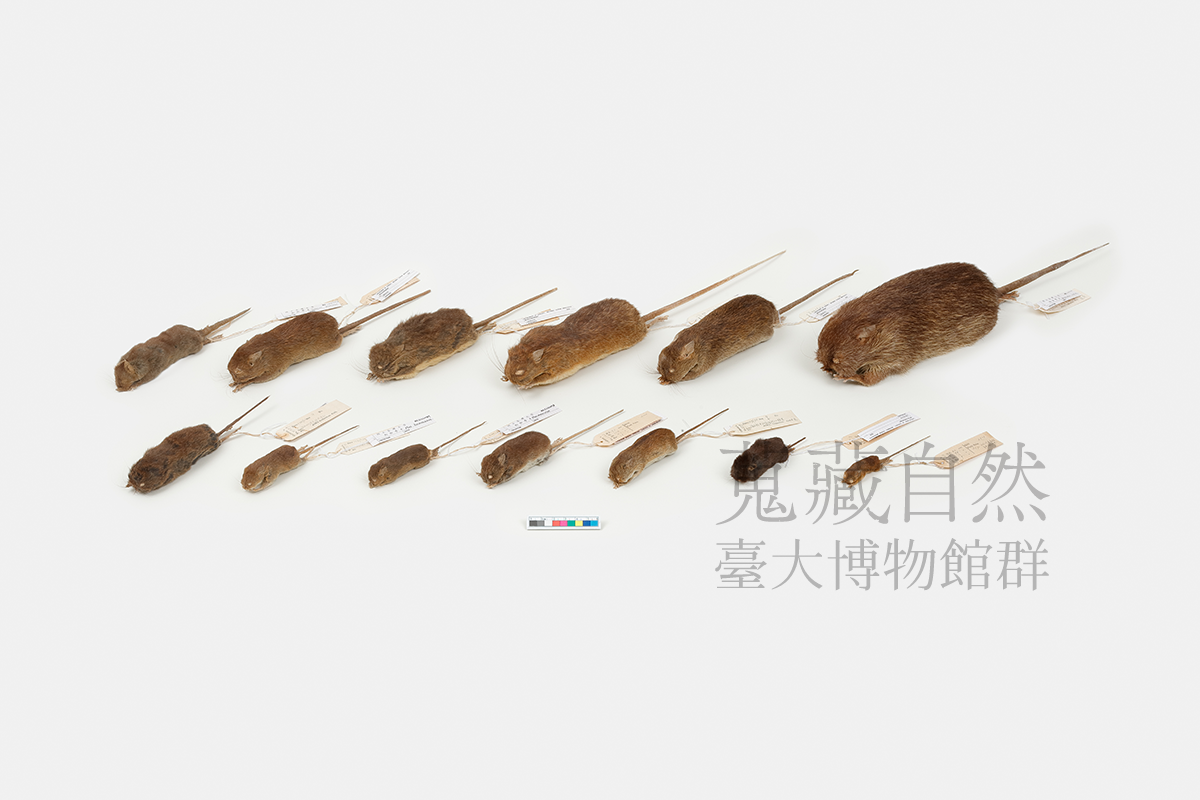
鼠類棍棒標本
Mouse Study Skins
本次展示出的為臺北帝國大學青木文一郎教授所主持的動物學第二講座所製作的鼠類棍棒標本,其中有青木教授本人所採集之鼠類。棍棒標本為動物剝製標本的一種,常用於鼠類及鳥類的標本保存及研究,將動物內部臟器移除,毛皮進行防腐處理,再以塞入填充物予以保存的標本。
The mouse study skins presented in this exhibition were produced by the research group of Professor Aoki Bunichiro at Taihoku Imperial University. Some of the specimens were collected by Professor Aoki himself. Study skins are a type of taxidermy specimen commonly used to preserve rodent and bird specimens for research purposes. To make a study skin, the internal organs of the animal are removed, and the skin, together with fur or feathers, is further treated with preservatives to prevent decay. The specimen is then stuffed for preservation.
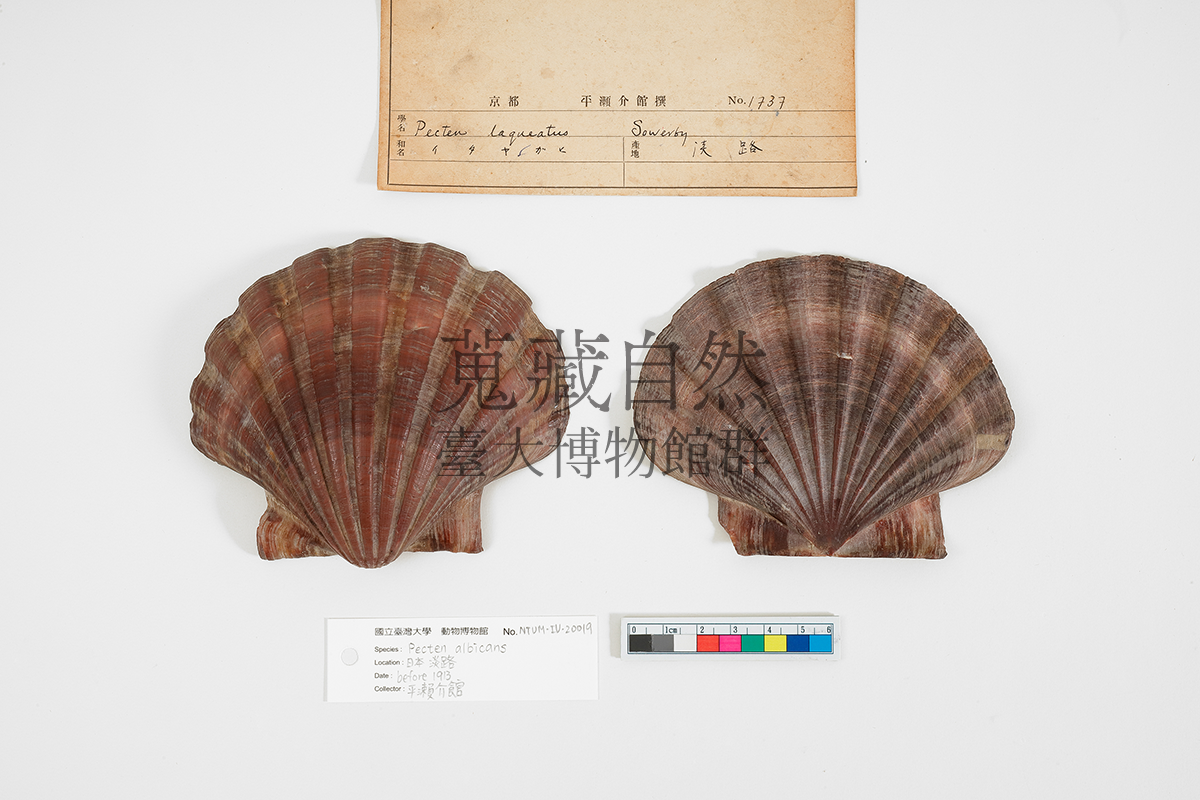
平瀨介館標本
Specimens from the Hirase Shellfish Museum Collection
平瀨介館(貝類博物館)成立於1913年日本京都市岡崎,館藏超過一萬多種的貝類標本,其中有三千多種日本產貝類及七千多種日本之外的貝類,採集地從北海道至臺灣本島及南洋。博物館於1919年吹起熄燈號,館藏之後分作三批,分別送往日本東京帝大、京都市以及臺北帝大。終戰之後這些貝殼標本一直被收納於臺大動物系(後與植物學系及漁業科學研究所組織重整為今日之生命科學系)一號館二樓角落的木盒裡,但它們始終沒被人發現。直到有次火災意外將木盒燒了一個洞,才被當時還是動物系學生的陳俊宏教授發現。經過一番考察之後,才確定這批貝類標本正是多年前那批來自日本平瀨貝類博物館的標本!
The Hirase Shellfish Museum was established in the Okazaki district of Kyoto, Japan in 1913. The museum housed over ten thousand shellfish specimens— with three thousand Japanese specimens and seven thousand oversea specimens. The specimens were collected from an area spanning Hokkaido in the north down to the main island of Taiwan and then south to Southeast Asia and Oceania. When the museum closed in 1919, the collection was divided up and delivered to Tokyo Imperial University, Kyoto City, and Taihoku Imperial University. The Taihoku portion of the collection was kept inside a wooden crate tucked away in a corner of the building in which Taihoku Imperial University’s Zoological Institute was housed. The Zoological Institute became the Department of Zoology of National Taiwan University after the end of World War II, which later reorganized and merged with the Department of Botany and Institute of Fishery Sciences to form the present Department of Life Science in 2003. These specimens were laid forgotten for many years, and it was only when a fire accident left the wooden crate that they were rediscovered by Chen Jiun-hong, then a student who is now a retired professor of the department. Following an investigation, these shellfish specimens were confirmed to be those from the Hirase Shellfish Museum nearly a century ago.

